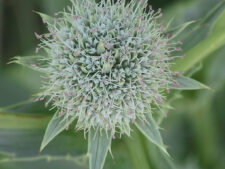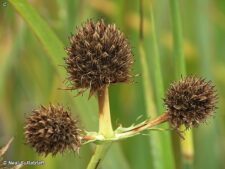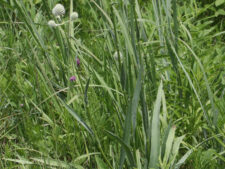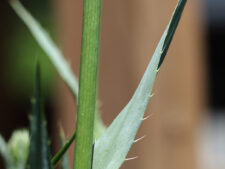
RATTLESNAKE MASTER
Eryngium yuccifolium
PARSLEY FAMILY (Apiaceae)
 Identification
Identification
- Flowering time - June, July, August
- Uncommon in prairies at NW and floodplain garden at FF
- Ball-shaped flower heads
- Long, narrow leaves with spines along edges
- Brown flower heads persist after flowering
This native perennial has a stout, smooth stem usually 2-3 feet tall. Leaves are rigid, long and narrow with small spines along their margins (A,D,E). The basal leaves may be up to 36 inches long by less than 1 1/2 inches wide, but they become progressively smaller further up the stem. Branching stalks support rounded flower heads up to 1 inch in diameter forming a somewhat flattened group of distinctive ball-like flower heads (A). Each head consists of many tiny, white 5-petaled flowers (B). Protruding styles and stamens with colored anthers give the head a fuzzy, pinkish appearance. The brown seed heads remain in place until late in the year (C).
This plant of prairies and open savannas is uncommon in the prairie restorations at Neale Woods and floodplain garden planting across from the parking lot on Gifford Road. It is north and west of its natural range which extends into extreme southeast Nebraska originating from seed used in the restorations and plantings.
Flowering occurs from June through August.
Eryngium is from the Greek for “a prickly plant,” reference to spines on the leaf margins (E).
Native Americans and pioneers used the roots for a number of medical conditions.
Other common names include Yucca-Leaf, Water Eryngo and Corn Snaketoot.
The content of NatureSearch is provided by dedicated volunteer Naturalists of Fontenelle Forest who strive to provide the most accurate information available. Contributors of the images retain their copyrights. The point of contact for this page is: Neal Ratzlaff.




